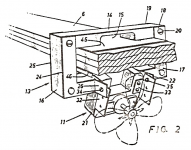I just filed this provisional patent but after I finished I remembered that some breaker controls are powered by what may be Parasitic inductance from the current flowing through them. I can't seem to find any information on this. It could also be through a different method. Does anyone know how this works?
I listed the beginning of the provisional below if anyone is interested. My idea was that it could be used for sensors and communication like in IoT nodes. I think I may have just waisted $120. Please let me know your thoughts.
Sorry if I posted this in the wrong spot. Wasn't sure where it would fit in
Parasitic inductance power supply
FIELD OF INVENTION
BACKGROUND
SUMMARY
I listed the beginning of the provisional below if anyone is interested. My idea was that it could be used for sensors and communication like in IoT nodes. I think I may have just waisted $120. Please let me know your thoughts.
Sorry if I posted this in the wrong spot. Wasn't sure where it would fit in
Parasitic inductance power supply
FIELD OF INVENTION
- The present invention relates to a system and method for providing low-voltage power to single or multiple devices using inductive coupling, which is facilitated through the mains power feeders of other apparatuses or equipment.
BACKGROUND
- There is a frequent requirement for extracting power from mains supply to operate low-voltage devices, such as sensors or communication equipment, which may be independent or integrated with the mains-powered equipment. The conventional approach involves direct connections to mains power, necessitating the use of mains-rated power supplies, fuses and complex power electronics. This method is often excessive for devices needing only milliampere-level current at very low voltage. An alternative, more efficient solution is the use of parasitic inductive coupling, which allows for the extraction of power without physically connecting to the mains conductors. This method can efficiently power various devices, including battery chargers, ensuring continuous power supply to low-power equipment, even when the mains power is switched off.
SUMMARY
- This invention involves a method where a coil of wire is wrapped around an AC mains power conductor connected to power utilization or generation equipment. Functioning similarly to a current transformer, the fluctuating magnetic flux from the mains conductor induces an electrical potential in the coil. This induced voltage is then modified and regulated through electronic circuitry, enabling it to power small, low-voltage loads. This method effectively eliminates the need for direct electrical connections to the mains conductors, offering a simpler and less intrusive power supply solution for low-power devices.

